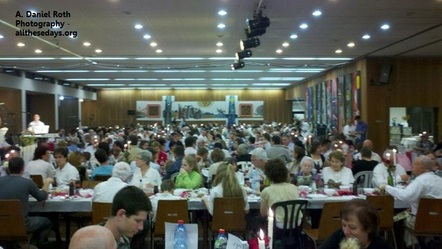 Passover at Kibbutz Mishmar Ha'emek, 2012 Passover at Kibbutz Mishmar Ha'emek, 2012 This article also appears at Jewschool.com Coverage in the media of mounting economic inequality around the world has become commonplace over the past few months. In many ways this coverage is late to the game as growing movements for equity and justice have left a wake in their paths. Perhaps there are lessons to be found in the ideas, crises, and visions of the Kibbutz movement. The century old Socialist experiment known as the Kibbutz elicits images of Jewish pioneers pitching tents, farmers tilling fields, and folks living in rural utopia. The reality today is, as with most things, much more complicated than collective memory can often allow. In the late 1970s the utopian dream began to deteriorate. Israel’s first non-labour government came into power and the status of the Kibbutz shifted as the country began to look towards the privatization of once national institutions. Former Secretary-General of Kibbutz Ein Hashofet and current Director of Givat Haviva Educational Institution, Yaniv Sagee sees the story of the Kibbutz as intertwined with that of the country. “The Kibbutz was seen as a public investment for building the state of Israel… Until 1977, and it served as a base for confidence for the Kibbutz members because they knew they can give to the Kibbutz everything that they have and they get from the Kibbutz everything they need. And they were sure it was going to happen because they didn’t only have to rely on the kibbutz. If it wasn’t successful the movement would help and if the movement needed support then there was the government,” he said. For many Kibbutz communities, it was the beginning of the end.
3 Comments
 La bandera de Hashomer Hatzair en los festejos del centenario del movimiento en Julio del 2013 La bandera de Hashomer Hatzair en los festejos del centenario del movimiento en Julio del 2013 This is the full Spanish version (translated by Kevin Ary Levin) of the written discussion in which Avigail Shaham details her community, movement, and vision. It has been reprinted in Chile and Argentina. The full English version is here. The shortened version appears at Jewschool.com ¿Qué haces? ¿Por qué te identificas como “shomeret” (integrante del movimiento Hashomer Hatzair)? ¿Qué atractivo tiene para vos? Mi nombre es Avigail. Nací y me crié en Jerusalén, rodeada por personas buenas e inspiradoras. Entre muchas otras actividades en mi infancia y adolescencia, fui parte del movimiento juvenil Hashomer Hatzair, un movimiento sionista y socialista de cien años de antigüedad que creó algunos de los más importantes fundamentos, estructuras y cultura de la sociedad cooperativa en Israel. Cuando egresé de la escuela secundaria, fui voluntaria en un año de servicio dentro del movimiento, durante el cual mis amigos y yo trabajamos como educadores en centros del movimiento juvenil a lo largo del país, y creamos para otros jóvenes la experiencia única del movimiento: la experiencia de una comunidad juvenil autónoma, creativa y liberadora dentro de la cual uno formula su personalidad a la luz de grandes ideas y a través de discusiones sociales y contemplación mutua. Mientras lo hacíamos, nos dimos cuenta de que éramos shomrim y shomrot en nuestro carácter [identificándose verdaderamente con los ideales del movimiento]. Nos dimos cuenta de que la ideología y la cultura del movimiento eran una brújula central para nosotros al evaluar nuestras acciones y comportamiento y al elegir nuestro rol y camino en el mundo. Queríamos continuar siendo shomrim y shomrot, y crear un recorrido de vida que expresara la esencia del movimiento.  The flag of Hashomer Hatzair movement at 100th anniversary celebrations in July 2013. The flag of Hashomer Hatzair movement at 100th anniversary celebrations in July 2013. This is the full version of the written discussion in which Avigail Shaham details her community, movement, and vision. The shortened version appears at Jewschool.com. This article has been translated into Spanish here and has been reprinted in Chile and Argentina. What do you do? Why do you find yourself identifying as a “Shomeret” (member of the movement)? What is the appeal for you? My name is Avigail, I was born and raised in Jerusalem, surrounded by good and inspiring people. Among many other activities in my childhood and adolescence, I was a member of Hashomer Hatzair youth movement - a 100 year old Socialist and Zionist movement which created some of the most inspiring foundations, structures and culture of cooperative society in Israel. When I graduated high school, I volunteered for a service year in the movement, in which my friends and I worked as educators in centers of the youth movement around the country, and created for other young people the unique experience of the movement - the experience of an autonomous, creative and liberating youth community in which one shapes their character in light of great ideas and through social discussions and mutual contemplation. As we were doing this, we realized we were Shomrim and Shomrot [truly identifying with the movement’s ideals] in character. We realized that the movement's ideology and culture was a central compass for us in evaluating our actions and behavior and in choosing our role and path in the world. We wanted to continue being Shomrim and Shomrot, and create a path of life which expresses the essence of the movement. |
Archives
May 2022
|
© 2022 A. Daniel Roth
 This work is licensed under a Creative Commons Attribution-NonCommercial-NoDerivatives 4.0 International License. |
